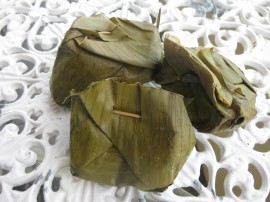Creating an edible tropical garden
03:46pm, Thursday 13 March 2025

Native orchids were once abundant in Thailand, now mostly gone in the forests. Hotels generally display man-made garden hybrids, while this is a true native orchid species, Aerides falcata
At first glance we have what appears to be a normal resort garden with palms, bougainvillea, clipped hedges, fountains and lawns. However as they stroll around the gardens, perceptive guests will notice the diversity of plants, trees and flowers bustling with bees, butterflies and birds, and they may even spot a member of staff gathering some delicacies from the trees for lunch or dinner.
Welcome to our edible forest garden!
Many people have heard of forest gardening through the work of English writer John Hart or Japanese no dig guru Masanobu Fukuoka, but my inspiration has been the Japanese philosopher Mokichi Okada, who wrote about gardening as a form of truth, beauty and virtue, similar to our motto of harmony, grace and natural beauty. Most importantly, he founded the school of nature farming in Japan early last century. His followers set up the Asia Pacific Natural Agricultural Network (APNAN) in Thailand in 1989 which teaches the use of beneficial microorganisms and working with nature as an effective way of growing healthy productive crops without the need for insecticides or artificial chemicals. APNAN, which is based in Saraburi in central Thailand, is a wonderfully practical organization which teaches its techniques to thousands of people every year and provides useful advice on everything from rice farming, to orchid growing, creating a self-sufficient farm and animal husbandry. I attended a course in Saraburi four years ago and use their techniques in our organic gardens.
My other inspiration is my husband Surin who grew up in a village in Ubon Ratchathani in northeast Thailand (Isaan). He describes an idyllic boyhood, tending buffalo, hunting and fishing and gathering wild herbs and fruits. According to Surin there was an amazing diversity of fauna and flora around his village, including fragrant beautiful flowers and delicious wild fruit. Since they had no electricity and a non-monetary economy, everything came from the land, including light from the resin of the ton ya nang tree (Dipterocarpus sp.), collected by Surin. Unfortunately the landscape of Isaan is very different today, with most of the native trees cut down and replaced by a monoculture of rice paddies. Even the rice grown today is far removed from the aromatic heritage varieties grown in the past.
Most of the trees from the northeast also grow well here in Chanthaburi and we are lucky enough to still have extensive pockets of bush around us which shower us with self-seeding trees such as the richly scented lam duan and ″mahaat″ (Artocarpus lakoocha), a tall forest tree which produces fragrant fruit like apricots.
When we came to Kung Wiman nine years ago we bought two pieces of land - three and a half acres where we built the resort and one and a half acres along the road where we planted around one thousand rare agar wood trees (Aquilaria sp.). We kept about 50 of the original small trees on the resort property and planted hundreds more. Although we don???t have the barking deer and tigers that Surin used to see 50 years ago, we do have many small creatures such as squirrels, bats, lizards, frogs, toads, native bees, butterflies and birds which give life and movement to the gardens. Five years ago we bought a further 15 acres nearby. There were a couple of ponds and swampland fed by fresh water springs and we restored the small lake which was once there, called 'White Water Lake'. Around the lake we have planted trees including natives such as agar wood and gankrau (Fagraea fragrans). Nearby we grow fruit and herbs and rice in the rainy season and we also graze three pet cows.
As well as commercial varieties of fruit we are growing heritage varieties of mango, durian and coconuts, wild fruits from Isaan such as ton waa chompu (Syzygium cumini) and local fruit varieties such as moon trees (Diospyrus decandra). In addition to staples such as lemongrass, galangal, kaffir limes and chillis, we harvest seasonal delicacies. This week we collected banana flowers and leaves, young tamarind and pigar leaves (Oroxylum indicum), hairy basil, holy basil, bitter cucumber, egg mangos, papaya, and a cherimoya.
We made tom yum with the tamarind leaves and a bitter cucumber salad seasoned with the tamarind leaves. Surin also made 'hor mok gai' with the banana flowers, which is the quintessential forest cuisine. Hor muk literally means mixed wrap and is a mash of herbs and meat wrapped in banana leaves. Traditionally it was grilled over charcoal but today it is usually steamed.
Any meat can be used - when Surin was a boy he had hor muk made with lizards, frogs, snake, rats or squirrels. Since today we have no desire or need to kill these lovely creatures we eat it instead with chicken or fish or bamboo shoots.
Surin's hok mok chicken recipe:
Banana flower
Chicken
Hairy basil
Chili
Lemongrass
Fish sauce
Spring onions
Garlic
All ingredients are pounded together in a mortar and pestle, wrapped in a banana leaf, sealed with a toothpick and steamed.
We offer a few forest cuisine dishes at the resort such as pork with chamuang leaves, chicken with neem leaves (Azadirachta indica) and soup with Siamese cardamom (Amomum villosum). Curious guests may be able to try other exotic recipes - by asking what our staff are eating or tracking me down in the garden to find out what???s in season.
Apart from being tasty, forest cuisine is also healthy. It is rich in vitamins and trace elements and almost everything we eat is also cited in our herb guide.
While we might not be able to recreate the idyllic world of Surin???s childhood, our gardens are a living reminder of what Thailand was once like and what it could be.
This blog was first published by Dokmai Gardens a Tropical Botanical Garden in Chiang Mai, Thailand. We would urge anyone who loves gardens or interested in tropical species to visit them.










